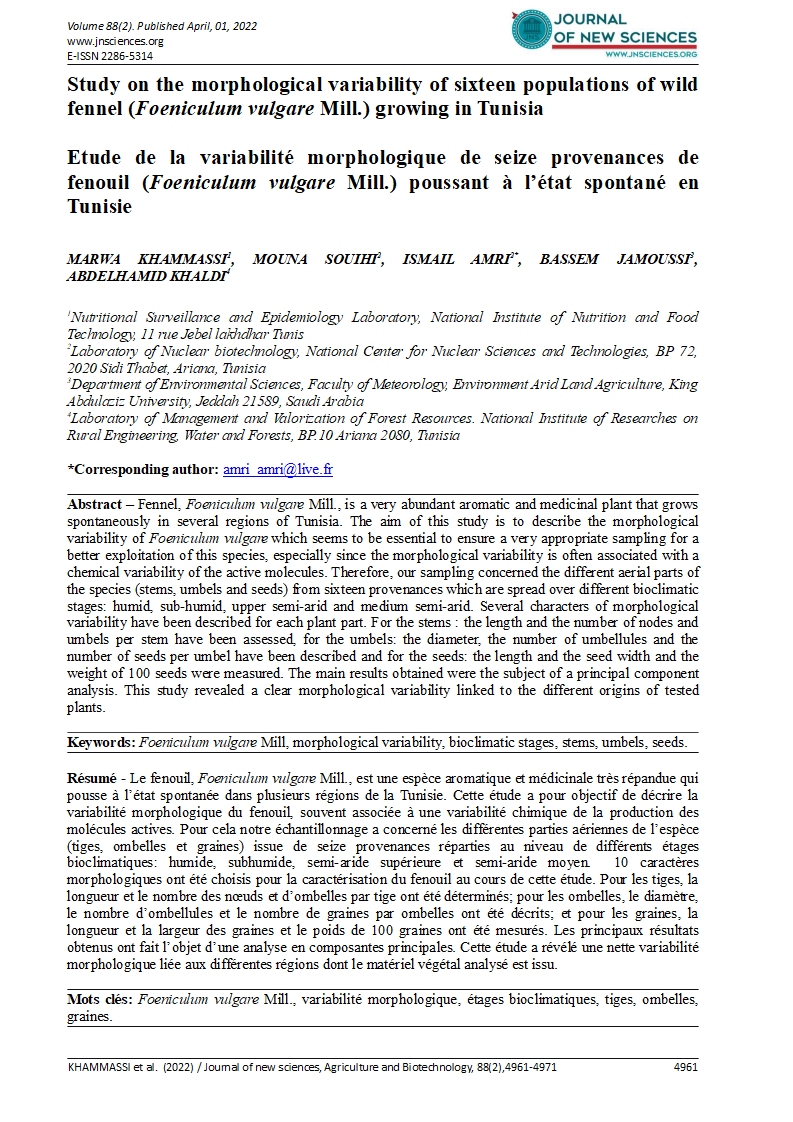

- Category: Volume 88
- Hits: 2399
Study on the morphological variability of sixteen populations of wild fennel (Foeniculum vulgare Mill.) growing in Tunisia
Etude de la variabilité morphologique de seize provenances de fenouil (Foeniculum vulgare Mill.) poussant à l’état spontané en Tunisie
MARWA KHAMMASSI1
MOUNA SOUIHI2
ISMAIL AMRI2
BASSEM JAMOUSSI3
ABDELHAMID KHALDI4
1Nutritional Surveillance and Epidemiology Laboratory, National Institute of Nutrition and Food Technology, 11 rue Jebel lakhdhar Tunis
2Laboratory of Nuclear biotechnology, National Center for Nuclear Sciences and Technologies, BP 72, 2020 Sidi Thabet, Ariana, Tunisia
3Department of Environmental Sciences, Faculty of Meteorology, Environment Arid Land Agriculture, King Abdulaziz University, Jeddah 21589, Saudi Arabia
4Laboratory of Management and Valorization of Forest Resources. National Institute of Researches on Rural Engineering, Water and Forests, BP.10 Ariana 2080, Tunisia
DOI: https://doi.org/10.55416/sunb.jns01.2204.08802
Abstract – Fennel, Foeniculum vulgare Mill., is a very abundant aromatic and medicinal plant that grows spontaneously in several regions of Tunisia. The aim of this study is to describe the morphological variability of Foeniculum vulgare which seems to be essential to ensure a very appropriate sampling for a better exploitation of this species, especially since the morphological variability is often associated with a chemical variability of the active molecules. Therefore, our sampling concerned the different aerial parts of the species (stems, umbels and seeds) from sixteen provenances which are spread over different bioclimatic stages: humid, sub-humid, upper semi-arid and medium semi-arid. Several characters of morphological variability have been described for each plant part. For the stems : the length and the number of nodes and umbels per stem have been assessed, for the umbels: the diameter, the number of umbellules and the number of seeds per umbel have been described and for the seeds: the length and the seed width and the weight of 100 seeds were measured. The main results obtained were the subject of a principal component analysis. This study revealed a clear morphological variability linked to the different origins of tested plants.
Keywords: Foeniculum vulgare Mill, morphological variability, bioclimatic stages, stems, umbels, seeds.
Résumé - Le fenouil, Foeniculum vulgare Mill., est une espèce aromatique et médicinale très répandue qui pousse à l’état spontanée dans plusieurs régions de la Tunisie. Cette étude a pour objectif de décrire la variabilité morphologique du fenouil, souvent associée à une variabilité chimique de la production des molécules actives. Pour cela notre échantillonnage a concerné les différentes parties aériennes de l’espèce (tiges, ombelles et graines) issue de seize provenances réparties au niveau de différents étages bioclimatiques: humide, subhumide, semi-aride supérieure et semi-aride moyen. 10 caractères morphologiques ont été choisis pour la caractérisation du fenouil au cours de cette étude. Pour les tiges, la longueur et le nombre des nœuds et d’ombelles par tige ont été déterminés; pour les ombelles, le diamètre, le nombre d’ombellules et le nombre de graines par ombelles ont été décrits; et pour les graines, la longueur et la largeur des graines et le poids de 100 graines ont été mesurés. Les principaux résultats obtenus ont fait l’objet d’une analyse en composantes principales. Cette étude a révélé une nette variabilité morphologique liée aux différentes régions dont le matériel végétal analysé est issu.
Mots clés: Foeniculum vulgare Mill., variabilité morphologique, étages bioclimatiques, tiges, ombelles, graines.

